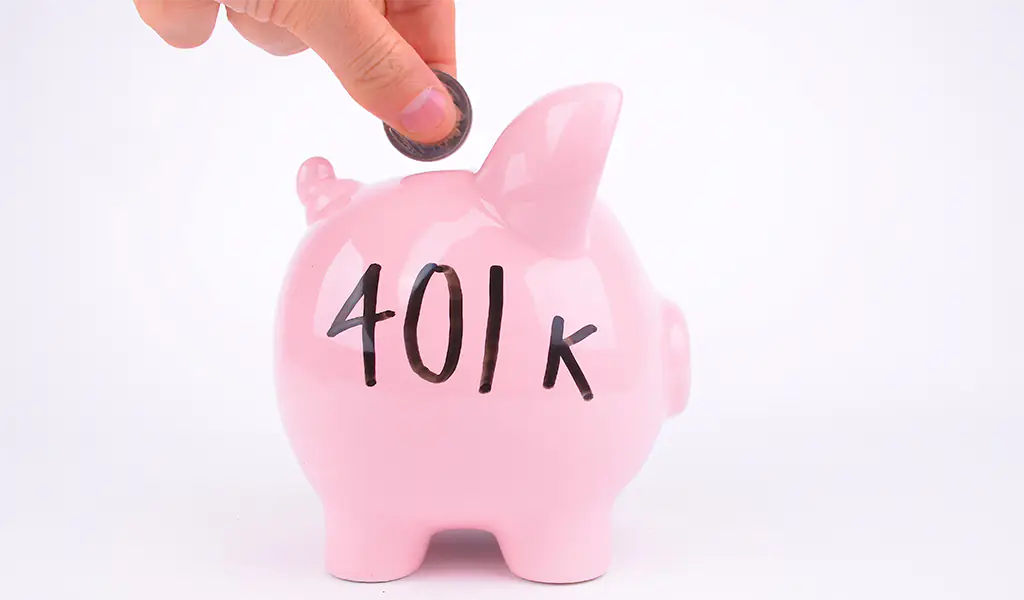UPDATED: April 6, 2022

A 401(k) plan is a retirement investment option offered by many employers. The tax benefits, high contribution limits, and investment flexibility make it an attractive way to begin or continue saving for retirement. But the icing on the investing cake is if you have an employer that offers a 401k match and you understand how to maximize it.
Table of Contents
What is a 401k Match?
Over the past several decades, the burden of saving for retirement has slowly shifted from employer to employee. While pension plans have fallen out of favor, defined contribution plans like the 401k are on the rise. To encourage employee participation in these plans, some employers offer a matching contribution.
These optional contributions can have a significant impact not only on employee participation but also on how much employees are willing to invest towards retirement. Employees must be making contributions to receive the match, and those who fail to participate in the plan would not be eligible for the employer funds.
Different Ways to Match
The specifics of a company’s 401k plan and match are at each employer’s discretion. Not all companies offer a match, and many smaller companies aren’t able to do so financially. The most popular matching options are 50% or 100% match of contributions up to 3% or 6% of salary.
For example, let’s say your employer agrees to match 100% of contributions up to 3%. If you make $50,000 per year, 3% is $1500. By committing to invest $1500 to your 401k plan, your employer would contribute another $1500 for a total overall investment of $3000.
Anything you choose to contribute on top of that 3% is unmatched but still invested and working towards your retirement goals.
If your employer offered a 50% match up to 6%, you’d need to contribute twice as much to receive the same match. A 6% contribution would be $3,000, with your employer adding another 50% or $1,500 for a total contribution amount of $4,500.
Understanding Contribution Limits
The employer match does not go towards your employee contributions but rather the overall limit. In 2021, employees can contribute up to a maximum of $19,500 (with a $6,500 catch-up contribution if you’re over 50 years old). The contribution limit for both employee and employer is $58,000 (or $64,500 including catch-up contributions).
For an employee making $100,000, you can contribute a full $19,500, and if your employer matches your contributions at 50% up to 6%, they’d be adding another $3,000 for a total of $22,500 ($100,000 * .06 = $6,000 * .5 = $3,000 + $19,500).
Invest Enough to Get the 401k Match
If you take away nothing else from this article, let it be this. If you do not contribute enough to get an employer match, you are literally leaving free money on the table. If it feels overwhelming and impossible to invest to the match point, break it down per paycheck. Often, it’s not as scary as you think.
Let’s again take the original example where you make $50,000 per year, and your employer will match 100% up to 3%. Your $1,500 contribution broken down over 24 pay periods is only $62.50. And that’s pretax money, which means you’ll feel it even less on your bottom line. It’s worth figuring out how to cut expenses by an extra $62.50 per paycheck to ensure you get your full 401k match.
If you just invest enough to get the match, you may not be on your way to max out your retirement savings. However, its free money, so don't leave it on the table.
Understand Your Vesting Schedule
Like many employee stock option offerings, employer 401k contributions may be subject to a vesting schedule. That means the company can enforce a waiting period until you become eligible to take 100% of your employer contributions if you terminate employment. However, your employee contributions are always fully vested and yours to keep if you leave the company after any period.
When you sign up for your plan, you’ll want to understand the vesting schedule and use it to guide your decisions if you consider leaving. If you become fully vested after 2 years and you’re looking for a new job after 1 year and 10 months, it might pay, quite literally, to wait it out past your second anniversary before you leave.
Time It Right
Some employers will only make match contributions on paychecks where 401k investment money is taken out. For anyone looking to max out contributions, it can pay to pace them to make sure you don’t hit the limit early.
For example, if you make $100,000 per year and plan to contribute 25% of your pretax income towards retirement savings, you’ll hit the $19,500 contribution limit before the year is up. That means you may have several pay periods with no contributions, and therefore no employer match.
Should I Still Contribute if I Don’t Get an Employer 401k Match?
Even without a 401k match, participating in the plan has numerous benefits. Plus, you never know if your company may be able to offer a match in the future. A 401k plan offers:
- Lower taxable income: Employee contributions to a 401k are tax-deductible, meaning you’ll be reporting a lower taxable income for the year.
- Tax-deferred growth: Money in your 401k will grow tax-deferred until you begin to make withdrawals after age 59½. Presumably, you’ll be in a lower tax bracket when you begin to remove funds than you are during your contributing years.
- Freedom of investment decisions: The underlying assets in a 401k are often decided by each employee. You can generally choose from a set fund list and create a more conservative or aggressive investment that matches your retirement plan and broader investment portfolio.
The Bottom Line
If you’re participating in a company 401k or are interested in doing so, find the appropriate person in your company’s HR department and ask about the match. Maximizing your employer’s 401k match is one of the easiest ways to boost your retirement savings with minimal effort.







Leave a Reply